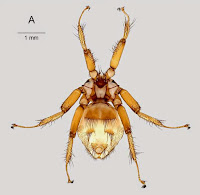Bat Fleas, Ischnopsyllidae, are specialised Fleas, Siphonaptera, which predominantly target Bats (flying animals present additional challenges for ectoparasites, and the different coverings of Birds and Bats mean that few species can target both; though both groups are highly prone to parasites, suggesting that targeting them is a successful ecological strategy). There are currently around 120 described species from every continent except Antarctica (which also lacks Bats).
In a paper published in the journal ZooKeys on 15 March 2016, Michael Hastriter of the Monte L. Bean Life Science Museum at Brigham Young University describes two new species of Bat Flea from Madagascar and Kenya. Both are placed in the genus Araeopsylla.
The first new species described is named Araeopsylla goodmani, in honour of Steven Goodman of the Field Museum of Natural History, who collected the specimen from which this species has been described, for his work on the Bats and small Mammals of Madagascar. The species is described from three female specimens obtained from a single male Black and Red Free-tailed Bat, Chaerephon jobimena, captured by the Namaza River in southern Madagascar.
Araeopsylla goodmani, female specimen in lateral view. Scale bar is 500 μm. Hastriter (2016).
The second species described is named Araeopsylla smiti, in honour of Francicus Smit of the Natural History Museum for his work on Fleas. The species is described from a single male specimen collected by Hastriter from a Spotted Free-tailed Bat, Chaerephon bivittatus, captured near Lake Harrington in Kenya's Rift Valley in 1968, and to date the only specimen of Araeopsylla ever collected in Kenya (though the genus is well known from other areas in Africa).
Araeopsylla smiti, male specimen. (8) Head and pronotum. (9) Terminal segments, before dissection. (10) Basimere, telomere, and eighth tergum. (11) Aedeagus, eighth sternum, and distal arm of ninth sternum, (Cr. Scl., Crescent Sclerite; LL, Lower Lobe; M.D.L., Median Dorsal Lobe; S.I.T., Sclerotized Inner Tube). (12) Hind tibia. (13) Fourth and fifth segments of distitarsomere 2. Scale bars are 200 μm (8–12), 100 μm (13). Hastriter (2016).
See also...
 Fossil Fleas from the Mesozoic - are they or aren't they? Putative Mesozoic fossil Fleas were first recorded in Australia and
Russia in the 1970s, with a number of recent publications describing
Fleas from the Jurassic and Cretaceous of China. These Fleas have been
speculated to have been ectoparasites (parasites...
Fossil Fleas from the Mesozoic - are they or aren't they? Putative Mesozoic fossil Fleas were first recorded in Australia and
Russia in the 1970s, with a number of recent publications describing
Fleas from the Jurassic and Cretaceous of China. These Fleas have been
speculated to have been ectoparasites (parasites... Nycteribiid Bat Flies from the southwest Indian Ocean. Nycteribiid Bat Flies are True Flies, Diptera, that have lost their
wings and adopted a lifestyle as ectoparasites of Bats. They have an unusual
lifestyle, with the larva maturing within the female Fly (which only produces
one larva at a time), then being ‘laid’ during the pupa stage. The female Fly
leaves her host Bat to lay this pupa, which hatches 3-4 weeks later, producing
a new...
Nycteribiid Bat Flies from the southwest Indian Ocean. Nycteribiid Bat Flies are True Flies, Diptera, that have lost their
wings and adopted a lifestyle as ectoparasites of Bats. They have an unusual
lifestyle, with the larva maturing within the female Fly (which only produces
one larva at a time), then being ‘laid’ during the pupa stage. The female Fly
leaves her host Bat to lay this pupa, which hatches 3-4 weeks later, producing
a new... A new species of Flea from the Philippines. Fleas of the Family Stivaliidae are found across Africa, Australasia and
Southeast Asia. They are specialist parasites of Rodents and Shrews
(and...
A new species of Flea from the Philippines. Fleas of the Family Stivaliidae are found across Africa, Australasia and
Southeast Asia. They are specialist parasites of Rodents and Shrews
(and...
Follow Sciency Thoughts on Facebook.
Franciscus
Smi
Franciscus
Smi
Franciscus
Smi


